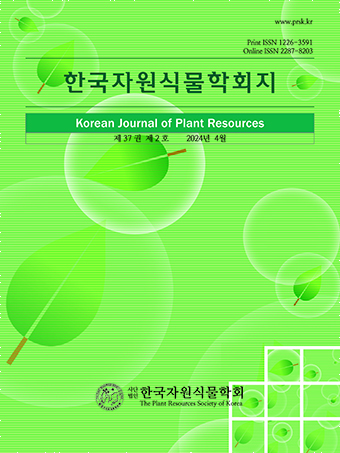Research Article
Abstract
References
Information
Akoja, S.S., O.J. Adebowale, O.M. Makanjuola and H. Salaam. 2017. Functional properties, nutritional and sensory qualities of maize-based snack (Kokoro) supplemented with protein hydrolysate prepared from pigeon pea (Cajanus cajan) seed. J. Culinary Sci. Tech. 15:306-319.
10.1080/15428052.2016.1259134Choi, Y.M., S. Lee, M.C. Lee, S. Oh, O. Hur, G.T. Cho, M. Yoon and D.Y. Hyun. 2018. Comparison of agricultural traits and physicochemical properties of lentil (Lens culinaris Med.), Chikpea (Cicer aretinum L.), and guar (Cyamopsis tetragonoloba L.) germplasm collected from tropical and Subtropical regions. Korean J. Breed. Sci. 50:453-462 (in Korean).
10.9787/KJBS.2018.50.4.453Kassa, M.T., R.V. Penmetsa, N.C. Garcia, B.K. Sarma, S. Datta, H.D. Upadhyaya, R.K. Varshney, E.J.B. von Wettberg and D.R. Cook. 2012. Genetic patterns of domestication in pigeon pea (Cajanus cajan (L.) Millsp.) and wild Cajanus relatives. PLoS ONE 7:e39563.
10.1371/journal.pone.003956322745789PMC3382124Liu, W., K. Yu, Z. Yuangang, F. Yujie, L. Meng, Z. Lin and L. Ji. 2010. Determination and quantification of active phenolic compounds in pigeon pea leaves and its medicinal product using liquid chromatography-tandem mass spectrometry. J. Chromatogr. A 1217:4723-4731.
10.1016/j.chroma.2010.05.02020965080Luo, M., X. Liu, Y. Zu, Y. Fu, S. Zhang, L. Yao and T. Efferth. 2010. Cajanol, a novel anticancer agent from pigeon pea [Cajanus cajan (L.) Millsp.] roots, induces apoptosis in human breast cancer cells through a ROS-mediated mitochondrial pathway. Chem. Biol. Interact. 188:151-160.
10.1016/j.cbi.2010.07.00920638373Rathinam, M., P. Mishra, M. Vasudevan, R. Budhwar, A. Mahato, A.L. Prabha, N.K. Singh, U. Rao and R. Sreevathsa. 2019. Comparative transcriptome analysis of pigeon pea, Cajanus cajan (L.) and one of its wild relatives Cajanus clatycarpus (Benth.). PLoS ONE 14:e0218731.
10.1371/journal.pone.021873131269083PMC6609033- Publisher :The Plant Resources Society of Korea
- Publisher(Ko) :한국자원식물학회
- Journal Title :Korean Journal of Plant Resources
- Journal Title(Ko) :한국자원식물학회지
- Volume : 33
- No :1
- Pages :50-61
- Received Date : 2019-12-04
- Revised Date : 2020-01-14
- Accepted Date : 2020-01-14
- DOI :https://doi.org/10.7732/kjpr.2020.33.1.50




 Korean Journal of Plant Resources
Korean Journal of Plant Resources







